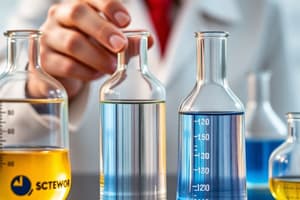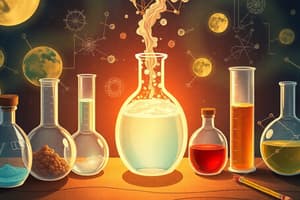Podcast
Questions and Answers
What determines the pitch of a sound?
What determines the pitch of a sound?
- Frequency of the sound wave (correct)
- Volume of the sound
- Length of the sound wave
- Amplitude of the sound wave
The Doppler effect occurs only when the observer is moving.
The Doppler effect occurs only when the observer is moving.
False (B)
What happens to sound waves when an ambulance moves towards you?
What happens to sound waves when an ambulance moves towards you?
The sound waves compress, increasing frequency and pitch.
Light can be __________, __________, and __________.
Light can be __________, __________, and __________.
Match the following colors with their position in the visible spectrum.
Match the following colors with their position in the visible spectrum.
What is temperature a measure of?
What is temperature a measure of?
Matter does not have any kinetic energy at absolute zero.
Matter does not have any kinetic energy at absolute zero.
What occurs when you add energy to a system in terms of temperature?
What occurs when you add energy to a system in terms of temperature?
The formula for calculating heat is __________ = m * c * ΔT.
The formula for calculating heat is __________ = m * c * ΔT.
Which method of heat transfer occurs through contact between objects?
Which method of heat transfer occurs through contact between objects?
What is the base unit of mass in the metric system?
What is the base unit of mass in the metric system?
A scientific theory is a statement about what happens in nature.
A scientific theory is a statement about what happens in nature.
What is defined as the distance between two points?
What is defined as the distance between two points?
The formula for calculating speed is _____.
The formula for calculating speed is _____.
Which of the following describes positive acceleration?
Which of the following describes positive acceleration?
Match the following definitions with their corresponding terms:
Match the following definitions with their corresponding terms:
What is the law of conservation of energy?
What is the law of conservation of energy?
Air resistance is a type of force that assists in motion.
Air resistance is a type of force that assists in motion.
When an object is in free fall, only ____ is acting on it.
When an object is in free fall, only ____ is acting on it.
What is the relation described in Newton's second law?
What is the relation described in Newton's second law?
What is the first step of the scientific method?
What is the first step of the scientific method?
A hypothesis is the independent variable in an experiment.
A hypothesis is the independent variable in an experiment.
What is meant by 'dependent variable'?
What is meant by 'dependent variable'?
The group that serves as the standard of comparison in an experiment is known as the ______.
The group that serves as the standard of comparison in an experiment is known as the ______.
Match the terms with their correct definitions:
Match the terms with their correct definitions:
Which of the following best describes a constant in an experiment?
Which of the following best describes a constant in an experiment?
Which type of current flows in only one direction?
Which type of current flows in only one direction?
An experiment must have a detailed materials list.
An experiment must have a detailed materials list.
What role does the independent variable play in an experimental setup?
What role does the independent variable play in an experimental setup?
A magnet is strongest at its poles.
A magnet is strongest at its poles.
A prediction of a possible answer to a problem or question is known as a ______.
A prediction of a possible answer to a problem or question is known as a ______.
What are the two main types of waves?
What are the two main types of waves?
Match the following variables to their descriptions:
Match the following variables to their descriptions:
In a transverse wave, the matter in the medium moves __________ to the motion of the wave.
In a transverse wave, the matter in the medium moves __________ to the motion of the wave.
Match the wave properties with their definitions:
Match the wave properties with their definitions:
Which of the following can make an electromagnet stronger?
Which of the following can make an electromagnet stronger?
Sound can travel through a vacuum.
Sound can travel through a vacuum.
What is the unit of frequency?
What is the unit of frequency?
A __________ wave is one where the matter in the medium moves back and forth in the same direction as the wave travels.
A __________ wave is one where the matter in the medium moves back and forth in the same direction as the wave travels.
Which phenomenon is responsible for the colors we see?
Which phenomenon is responsible for the colors we see?
Flashcards
Scientific Method
Scientific Method
A series of steps used to investigate a natural event or solve a problem.
Question/Problem
Question/Problem
A question that can be answered through experimentation.
Hypothesis
Hypothesis
A possible answer to the question or problem, which is testable.
Independent Variable
Independent Variable
Signup and view all the flashcards
Dependent Variable
Dependent Variable
Signup and view all the flashcards
Experiment
Experiment
Signup and view all the flashcards
Control Group
Control Group
Signup and view all the flashcards
Constants
Constants
Signup and view all the flashcards
Experimental Group
Experimental Group
Signup and view all the flashcards
Measurable & Repeatable
Measurable & Repeatable
Signup and view all the flashcards
Scientific Law
Scientific Law
Signup and view all the flashcards
Scientific Theory
Scientific Theory
Signup and view all the flashcards
Mass
Mass
Signup and view all the flashcards
Volume
Volume
Signup and view all the flashcards
Length
Length
Signup and view all the flashcards
Speed
Speed
Signup and view all the flashcards
Velocity
Velocity
Signup and view all the flashcards
Acceleration
Acceleration
Signup and view all the flashcards
Reference Frame
Reference Frame
Signup and view all the flashcards
Force
Force
Signup and view all the flashcards
What is current electricity?
What is current electricity?
Signup and view all the flashcards
What is magnetism?
What is magnetism?
Signup and view all the flashcards
What are crests?
What are crests?
Signup and view all the flashcards
What are troughs?
What are troughs?
Signup and view all the flashcards
What is amplitude?
What is amplitude?
Signup and view all the flashcards
What is wavelength?
What is wavelength?
Signup and view all the flashcards
What is frequency?
What is frequency?
Signup and view all the flashcards
What is a mechanical wave?
What is a mechanical wave?
Signup and view all the flashcards
What is an electromagnetic wave?
What is an electromagnetic wave?
Signup and view all the flashcards
What is a compressional wave?
What is a compressional wave?
Signup and view all the flashcards
What determines the pitch of a sound?
What determines the pitch of a sound?
Signup and view all the flashcards
Doppler Effect
Doppler Effect
Signup and view all the flashcards
What is light?
What is light?
Signup and view all the flashcards
Transparent vs. Opaque
Transparent vs. Opaque
Signup and view all the flashcards
Law of Reflection
Law of Reflection
Signup and view all the flashcards
Visible Spectrum
Visible Spectrum
Signup and view all the flashcards
How is an object's color determined?
How is an object's color determined?
Signup and view all the flashcards
Matter, Energy, and Atoms
Matter, Energy, and Atoms
Signup and view all the flashcards
What is Temperature?
What is Temperature?
Signup and view all the flashcards
Methods of Heat Transfer
Methods of Heat Transfer
Signup and view all the flashcards
Study Notes
Nature of Science
- Scientific Method: A series of steps used to investigate natural occurrences or solve problems.
- Question/Problem: A question or problem that can be solved through experimentation.
- Hypothesis: A proposed answer to a problem or question, often stated as a prediction.
- Independent Variable: The variable that is intentionally changed by the experimenter.
- Dependent Variable: The variable that might change as a result of changes to the independent variable.
- Experiment: A procedure that includes a detailed materials list, measurable (quantifiable) outcomes, and allows for repetition.
- Control Group: A standard of comparison in an experiment.
- Constants: Factors the experimenter attempts to maintain the same across all experimental groups.
- Scientific Law: A statement about natural occurrences.
- Scientific Theory: An explanation of observations supported by evidence.
- Mass: The amount of matter in an object.
- Volume: The amount of space an object occupies.
- Length: The distance between two points.
- Meter: The base unit of length in the metric system.
- Gram: The base unit of mass in the metric system.
- Liter: The base unit of volume in the metric system.
Metric Conversions & Measurements
- Learn to convert between metric units.
- Master the procedure of finding volume using water displacement.
- Understand the order of metric unit prefixes.
Speed, Velocity, and Acceleration
- Speed: How fast an object is moving.
- Motion: The act of moving.
- Velocity: Speed and direction of an object's motion.
- Acceleration: The rate of change in velocity.
- Reference Frame: The background used to define an object's motion.
- Positive Acceleration: A positive number on a velocity-time graph with a positive slope.
- Negative Acceleration: A negative number on a velocity-time graph with a negative slope (deceleration).
- Speed Formula: Speed = Distance / Time
- Velocity Formula: Velocity = Distance/Time with direction.
- Acceleration Formula: Acceleration = (Final Velocity - Initial Velocity) / Time
- Calculate speed, velocity, and acceleration from word problems, graphs, and charts.
- Convert minutes to seconds.
- Interpret speed and acceleration graphs.
- Round to the nearest hundredth.
- Properly use units in calculations.
Force and Newton's Laws
- Force: A push or pull exerted on an object.
- Gravity: A force that pulls objects downwards.
- Free Fall: Motion where only gravity acts on an object.
- Isaac Newton: Described the relationship between motion and force.
- Friction: A force opposing motion between two touching surfaces.
- Rolling Friction: Friction between a rolling surface and another surface.
- Sliding Friction: Friction between two sliding surfaces.
- Static Friction: Friction between two surfaces that aren't moving.
- Weight: The force of gravity on an object.
- Balanced Force: Forces that don't change an object's motion (net force is zero).
- Unbalanced Force: Forces that do change an object's motion (net force is not zero).
- Net Force: The combination of all forces acting on an object.
- Inertia: The tendency of an object to resist changes in its motion.
- Air Resistance: Friction between a moving object and air molecules.
- Newton's First Law: An object at rest stays at rest, and an object in motion stays in motion with the same speed and in the same direction unless acted upon by an unbalanced force.
- Newton's Second Law: Force = mass × acceleration.
- Newton's Third Law: For every action, there is an equal and opposite reaction.
- Calculate force, net force, and weight.
Work, Power, and Machines
- Work: The transfer of energy when a force moves an object over a distance.
- Power: The rate at which work is done.
- Machine: A device that makes work easier.
- Mechanical Advantage: The advantage gained by using a machine (output force/input force).
- Input Force: The force applied to a machine.
- Output Force: The force exerted by the machine.
- Simple Machines: Machines that do work in one movement.
- Complex Machines: Machines that consist of multiple simple machines working together.
- Work Formula: Work = Force × Distance
- Power Formula: Power = Work / Time
- Mechanical Advantage Formula: Mechanical Advantage = Output Force / Input Force.
- Understand how different simple machines (levers, pulleys, inclined planes, screws, wedges, and wheel & axles) work and the mechanical advantage of each.
Energy
- Law of Conservation of Energy: Energy cannot be created or destroyed; it can only change form.
- Types of Energy: Chemical, nuclear, electrical, magnetic, light, sound, electromagnetic, mechanical, heat.
- Energy Transformations: Examples of energy changing from one form to another.
Electricity
- Electricity: The flow of electrons.
- Law of Charges: Opposites attract, likes repel.
- Static Electricity: Accumulation of electric charges producing a discharge. (Conduction, Induction, Friction)
- Current Electricity: Flow of electrons through a circuit (needs a closed circuit).
- Ohm's Law: (Relates current, voltage, and resistance).
- Parallel Circuits: Current alternates.
- Series Circuits: Current flows in one direction.
Magnetism
- Magnetism: A force and type of energy.
- Magnet Strength: Strongest at its magnetic field.
- Magnetic Poles: Two opposite poles; where magnetism is strongest.
- Electromagnet: Electricity creates a magnetic field. (Ways to strengthen an electromagnet, coil number, wire thickness, metal size, battery size)
- Magnetization: Organized electron alignment.
Waves
- Wave Properties: Definition, medium, direction of energy transfer and particles, frequency, wavelength, amplitude, compressional vs. transverse waves.
- Types of Waves: Mechanical, electromagnetic
- Transverse Waves: Matter moves up and down perpendicular to wave motion (Examples: crowd wave).
- Compressional (Longitudinal) Waves: Matter moves back and forth in the same direction as the wave motion. (Examples: Slinky).
- Wave Components: Crests, troughs, amplitude, wavelength, frequency.
- Electromagnetic Spectrum: Characteristics
- Wave Phenomena: Reflection, refraction, diffraction, interference, constructive and destructive interference
Sound
- Sound: A compressional wave produced by vibrating matter.
- Sound Transmission: Needs a medium to travel (air).
- Sound Speed: Different speeds in different media.
- Sound Pitch: Depends on frequency.
- Doppler Effect: Observed change in frequency when source or observer is moving.
Light
- Light: Allows us to see.
- Light Interaction with Objects: Reflection, refraction, transmission.
- Law of Reflection: Incidence angle = Reflection angle.
- Visible Spectrum: The combination of colors of visible light.
- Color Perception: An object absorbs colors not reflected.
Heat and Temperature
- Heat and Matter: The universe is matter and energy, matter is made of atoms, and atoms are always in motion.
- Temperature: Average kinetic energy of particles.
- Temperature Measurement: Thermometers, qualitative vs. quantitative data.
- Heat Transfer: Conduction, convection, radiation.
- Specific Heat: Amount of heat needed to raise 1 kg of a material by 1°C. (Units, formula, meaning of variables, and calculations)
Studying That Suits You
Use AI to generate personalized quizzes and flashcards to suit your learning preferences.




